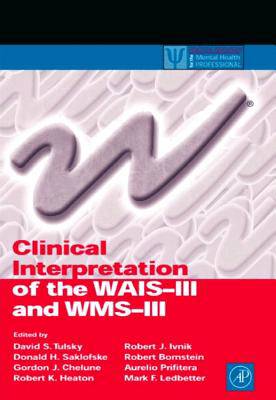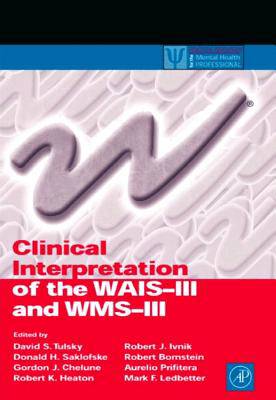
- Afhalen na 1 uur in een winkel met voorraad
- Gratis thuislevering in België vanaf € 30
- Ruim aanbod met 7 miljoen producten
- Afhalen na 1 uur in een winkel met voorraad
- Gratis thuislevering in België vanaf € 30
- Ruim aanbod met 7 miljoen producten
Zoeken
Clinical Interpretation of the WAIS-III and Wms-III
David S Tulsky, Donald H Saklofske, Gordon J Chelune, Robert K Heaton, Robert J Ivnik, Robert Bornstein, Aurelio Prifitera, Mark F Ledbetter
Paperback | Engels
€ 139,95
+ 279 punten
Omschrijving
This guide to the WAIS-III and WMS-III tests is written to help clinical practitioners achieve efficient and accurate interpretations of test results. The only interpretive guide to be based on data obtained while standardizing the tests, this reference source provides new models for interpreting results, as well as practical information on the diagnostic validity, demographically corrected norms, and accuracy of the tests in measuring intelligence and memory.
The focus of information is to allow clinicians to reduce variance in the interpretations of scores, indicating how best to factor in socio-economic status of respondents, interpreting meaningful change in serial assessments, and scoring with alternate or omitted sub-tests. Also included in the book are chapters on accommodating clients with disabilities. The final chapter discusses frequently asked questions (with answers) on the use and interpretation of the tests, as well as practical issues to help make scoring time-efficient and accurate.
KEY FEATURES
* Only guide to be based on data obtained in the standardization of the tests
* Practical examples given to help guide interpretation of scores
* Focuses on information to make faster, more accurate scoring interpretations
The focus of information is to allow clinicians to reduce variance in the interpretations of scores, indicating how best to factor in socio-economic status of respondents, interpreting meaningful change in serial assessments, and scoring with alternate or omitted sub-tests. Also included in the book are chapters on accommodating clients with disabilities. The final chapter discusses frequently asked questions (with answers) on the use and interpretation of the tests, as well as practical issues to help make scoring time-efficient and accurate.
KEY FEATURES
* Only guide to be based on data obtained in the standardization of the tests
* Practical examples given to help guide interpretation of scores
* Focuses on information to make faster, more accurate scoring interpretations
Specificaties
Betrokkenen
- Auteur(s):
- Uitgeverij:
Inhoud
- Aantal bladzijden:
- 618
- Taal:
- Engels
Eigenschappen
- Productcode (EAN):
- 9781493302079
- Verschijningsdatum:
- 13/05/2003
- Uitvoering:
- Paperback
- Formaat:
- Trade paperback (VS)

Alleen bij Standaard Boekhandel
+ 279 punten op je klantenkaart van Standaard Boekhandel
Beoordelingen
We publiceren alleen reviews die voldoen aan de voorwaarden voor reviews. Bekijk onze voorwaarden voor reviews.











